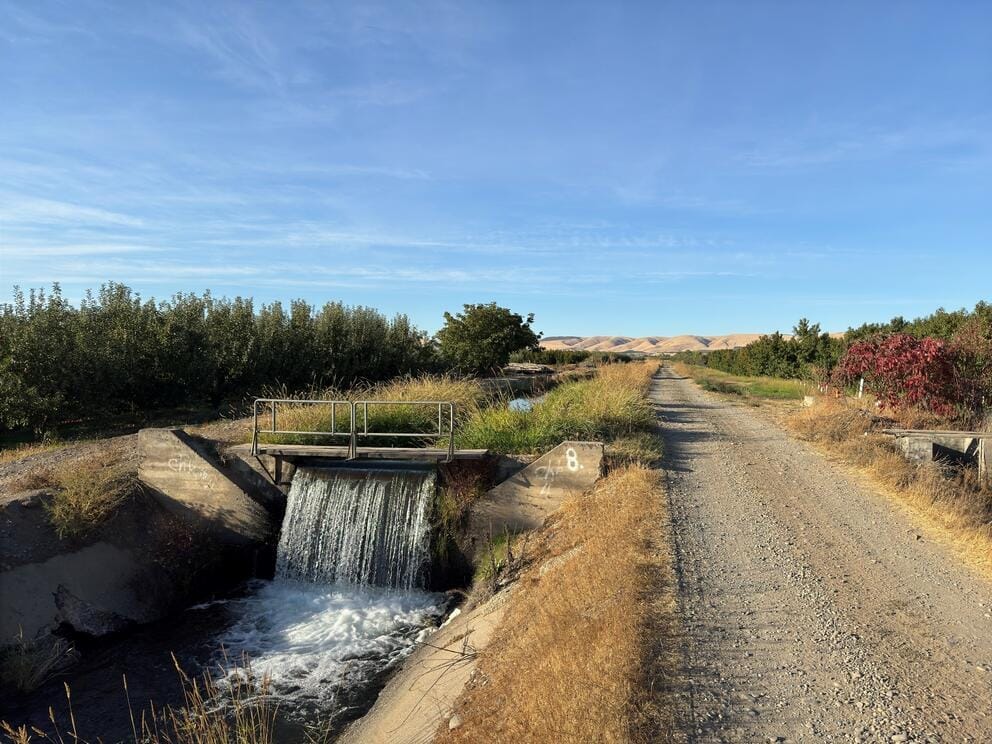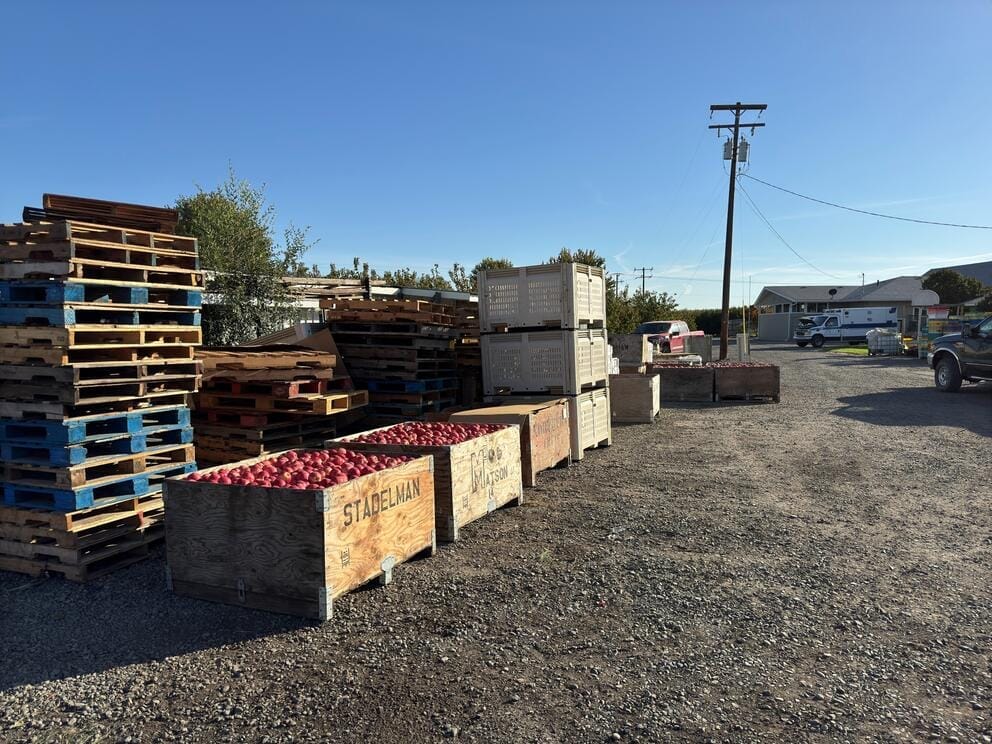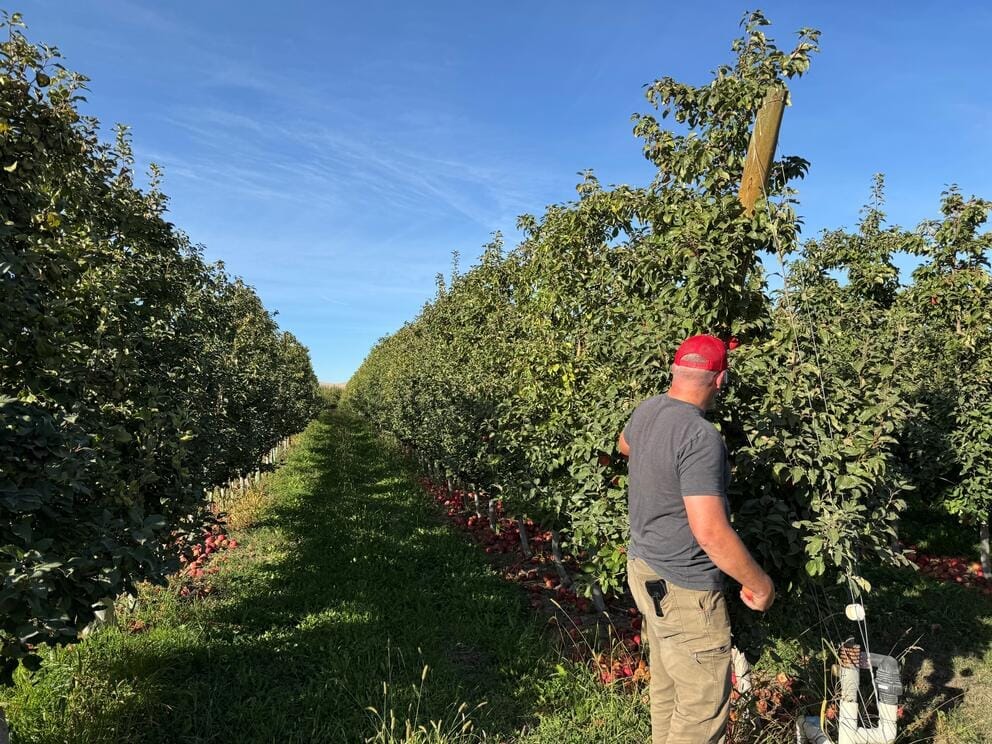WAPATO — Tim Calhoun operates a small orchard and fruit distribution business about two miles off the Yakima River. Walking through rows of apple trees in October as the end of the harvest approached, he explained how he came to run the operation.
“My dad was doing the same thing I’m doing now, doing the sales, and I was just a truck loader. I’d load trucks, help customers,” he said. “That’s how I started. And then went to college, and then came back and started full time in 2006.”
Since Calhoun’s grandfather started farming on the site in 1969, the family has built the operation from roughly a dozen acres to 170 — about the size of 130 football fields.
Calhoun estimates apples make up about 40% of his total acreage, with pears, cherries and soft fruits such as peaches filling out the rest. This season, the operation produced roughly 1.35 million pounds of apples.
What does it take to make that harvest possible?
In addition to a perfect climate and nearly year-round hard work by Calhoun, his family and employees, the answer is water. Roughly 23 million gallons of it, carried from the Yakima River-fed Wapato Irrigation Canal to his orchard. That water allows him to produce some of the best apples in the world on otherwise semi-arid land.
The Yakima River Basin is home to roughly one-third of Washington’s 188,000 acres of apple orchards, according to an estimate from the Washington Department of Agriculture.
Those orchards grow Washington’s leading crop, accounting for nearly 70% of U.S. apple production and almost $2 billion of the $14 billion Washington crops were worth last year, according to the U.S. Department of Agriculture.
And, with about 80% of Washington agriculture using water from either the U.S. Bureau of Reclamation’s Yakima Basin irrigation project or its Columbia Basin Project, the Columbia River system is the single biggest force driving this essential sector of the state’s economy.
Origins of an economy
Over the course of the 20th century, dams transformed the Columbia. It was once a wild and powerful river system that ferried millions of fish from the Pacific Ocean as far inland as Wyoming. After damming, the river became a series of creeping pools powering the West both literally and economically.
While many of the dams were built primarily for hydroelectric power, flood control and commercial navigability, others provided the necessary infrastructure to store hundreds of billions of gallons of water. That water then soaked vast expanses of the desert east of the Cascade Mountains, transforming life there.
Opened in 1910, the Bureau of Reclamation’s Yakima Project was an early and successful example of what the agency described in 1993 as its project of “reclaiming of the ‘Great American Desert.’”
In 1952, about 10 years after the Grand Coulee Dam was completed, the Columbia Basin Project came online. It’s still the largest water reclamation project in the U.S.
The project holds water rights to roughly 3% of the Columbia River’s entire yearly output, said Marc Maynard, who runs the project for the bureau. He estimated the Columbia Basin Project uses a little less than 90% of its allotment each year. But through the reuse of water throughout the project, it turns the roughly 880 billion gallons it draws each year to more than 1 trillion. Those numbers vary year to year.
Today, Washington’s two marquee irrigation projects supply almost two-thirds of the state’s roughly 1.8 million irrigated acres through hundreds of miles of canals.
But the projects didn’t just make Central Washington’s agricultural regime possible by carrying the water deep into the desert. They also deliver the water when it’s needed but not otherwise available.

An offshoot of the Wapato Irrigation Canal that cuts through Tim Calhoun’s orchard. The canal is fed by the Yakima River. (Henry Brannan/The Columbian)
“To make this possible, you’ve got to re-time the flow of water in the rivers,” economist Michael Brady explained. “To then have the flow when it’s really valuable for growing things, which is in the middle of the summer.”
Brady is a professor at Washington State University in Pullman who studies the production of irrigated crops and how water management affects them.
That “re-timed” water has not just made agriculture possible, but also much of what — and who — exists throughout the state.
“Driving around nearly any part of Eastern Washington until you get almost all the way to the Idaho border, it’s hard not to be left with the sense that irrigated agriculture is what drives the economy,” he said.
Apples alone generate about 46,000 full-time jobs in Washington, along with another roughly 22,000 indirect jobs, such as researchers and truck drivers, said Jon DeVaney, president of the Washington State Tree Fruit Association. The figures come from a 2021 economic impact report the trade association commissioned.
“Just direct output of apples and the apple economy is close to $6 billion in Washington state each year,” he said. “And when you look at the indirect economic activity generated, it’s close to $9 billion.”

Freshly harvested apples wait to be sold to customers on Tim Calhoun’s family orchard Oct. 2. Washington’s apple industry relies on water from the Columbia River system. (Henry Brannan/The Columbian)
That amounts to a little more than 1% of the state’s gross domestic product, the total market value of all the goods and services produced by labor and property in Washington and a standard measure of an area’s economic output. And while that 1% may be small compared to the revenues of coastal tech Goliaths including Amazon and Microsoft, it’s essential for life east of the Cascades.
This year’s harvest
As growers picked some of their last apples of the crop year, DeVaney said it’s good that this year’s harvest, although on the large side of average, was about 3% smaller than last year.
“Last year we had quite a large crop and rapid escalation of costs, and when you have an abundant supply, that tends to soften pricing a little bit,” he said. “And so to have had rapid inflation in our input costs followed by a softening of our pricing — a lot of growers took real economic harm and had losses this last year that were pretty painful.”
Calhoun, the tree fruit grower and broker in Wapato, echoed that concern, citing overproduction in particular.
“We probably would need to get rid of 20 to 30 million [40-pound] boxes in the state of Washington to become profitable again,” he said. “Basically every box, every bin that we’re going to pick this crop year — all these apples are going to net the farmers a loss this year.”

Apple farmers like Tim Calhoun take just a short break between the apple harvest and pruning trees for the next crop. (Henry Brannan/The Columbian)
Other factors affecting the apple market include early COVID-19-era supply chain struggles, transportation costs, competition from the rest of the world, increasing consolidation led by private equity-backed agribusiness companies and retaliatory tariffs stemming from 2018 tariffs the U.S. put on some countries.
But, after nearly 20 years in the business, third-generation farmer Calhoun quickly shifted his attention to the next buyer, loading his truck to the gills with fresh fruit. And, on the phone this week after he finished this year’s harvest, Calhoun’s attention was already on next year.
“They [customers] are like, ‘Oh, what do you do with all your free time in the winter?’” he said. “We’re going to take, like, two and a half weeks off, and then we go right back to pruning for next year.”
The Columbian originally published this article on Nov. 16, 2024.

